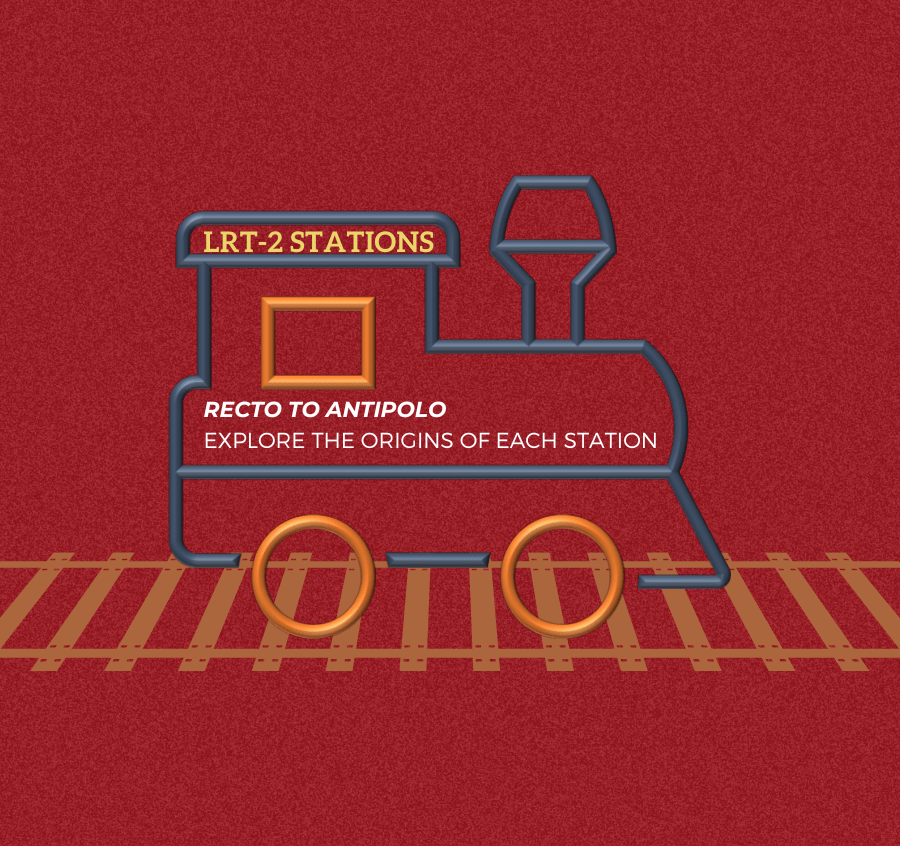LRT-2: The Origin of the Names of the Stations From Recto to Antipolo

Long lines for tickets. Numerous faces of strangers. Waiting for a train to stop by. A familiar, yet repetitive cycle for an LRT commuter. The Light Rail Transit Line 2 or LRT-2 originally travels from Recto to Santolan. But with the recent extension, stations of Marikina-Pasig and Antipolo were added.

LRT-2 is part of a daily lifestyle of a Filipino commuter. People may deal with riding a train packed with passengers, but it definitely avoids heavy traffic. But when traversing each station, one may wonder how its names are formed. To answer that, take a ride now as we explore 13 stations of LRT-2 to learn the origin!
1. Recto Station
The first station, Recto, connects to the LRT-1 Doroteo Jose Station. This was previously called Calle Azcarraga, but the name was changed after the author of the 1935 Philippine Constitution— the late Claro M. Recto, a politician and jurist.
2. Legarda Station
Legarda, the second station that was previously known as Calle Alix. From 1907 to 1912, a Philippine resident commissioner went to the United States, named Hon. Benito Legarda. Furthermore, he was part of the Malolos Congress. So, if you’re a student at San Beda College or Centro Escolar University, Legarda Station is your drop-off.
3. Pureza Station
Coming with the third station, Pureza, is derived from the Spanish word that means purity. Known destination in this Sta. Mesa area is the Polytechnic University of the Philippines and Mabini Shrine.
4. V. Mapa Station
The Calle Buenavista before, called Victorino Mapa today. He was the second chief justice after Cayetano Arellano. The fourth station of the LRT is known for V. Mapa in short. Moreover, located in Sta. Mesa district is the closest to places like SM Sta. Mesa, UERM, and PUP still.
5. J. Ruiz Station
J. Ruiz, short for Juan Ruiz, a Katipunan member. He was one of the 171 men who died in the First Battle of Katipunan, located in San Juan City. This stop is recommended when visiting Pinaglalaban Shrine and Santuario del Santo Cristo.
6. Gilmore Station
This sixth station was named after Eugene Allen Gilmore who served as the vice governor-general of the Philippines from 1922 to 1930. He also served the College of Law at the University of Iowa and the University of Pittsburgh as a Dean.
7. Betty-Go Belmonte Station
Betty Go-Belmonte was the late spouse of Feliciano “Sonny” Belmonte Jr., the former House Speaker Representative. A Filipina journalist who founded the Philippine Daily Inquirer and The Philippine Star broadsheets. This seventh station is near Trinity University of Asia, Kalayaan College, and Cubao Cathedral.
8. Araneta-Cubao Station
Araneta came from the name of J. Amado Araneta who saw the Cubao as the leading commercial spot of the Philippines during the late 1950s. Meanwhile, Cubao, derived from old folklore, was a place where witches lived. Every time someone will breach their territory, the witches shapeshift into Kuba— making them trespassers scream “Kuba, o!”
9. Anonas Station
The ninth station of LRT-2, Anonas, was named after a fruit that has the same name. A custard apple in English term that grew abundantly in Brgy. Quirino in the early 1950s. The station is near at Technological Institute of the Philippines and World Citi Medical Center.
10. Katipunan Station
Derived from the revolutionary group which Andres Bonifacio founded, the Kataastaasan, Kagalanggalangan, Katipunan ng mga Anak ng Bayan (KKK) to fight against the Spaniards. If you plan to go to the University of the Philippines-Diliman or Ateneo de Manila University, this tenth station makes up the best choice.
11. Santolan Station
Santolan came from the idea of santol trees that grew abundantly in the barangay. The eleventh station is near SM Markina and the riverbank of the city.
12. Marikina-Pasig Station
Marikina-Pasig Station was named after the city itself. The former city was derived from Mariquina, a town in Spain. However, Mariquit-na was the original term for the area. Meanwhile, Pasig came from an old Sanskrit word, meaning “river flowing from one body of water to another”.
13. Antipolo Station
Tipolo, a breadfruit tree that grew abundantly in the Antipolo area, derived its name from it. This is the last station of LRT-2, a city in Rizal province that became a fruit of the project extension of the rail transit.
In case you missed it, LRT-2 offers free rides for students from August 22nd until November 5th of 2022. So, if you’re school is near some of these stations, just bring your School ID or Registration Form to Passenger Assistance Office (PAO) for your ticket. Have a safe ride!






